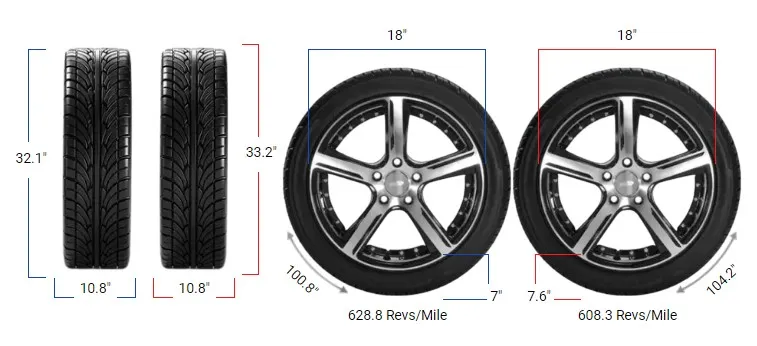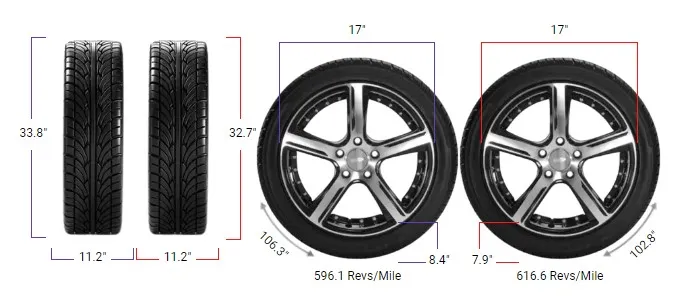Tire Size 275/60r20 vs 275/65r20

Are you considering upgrading your vehicle’s tires from 275/60R20 to 275/65R20? We’ll explore the key differences between these two tire sizes and help you make an informed decision.
- 3.3% increase in overall tire diameter exceeds recommended range
- 0.54-inch taller sidewall improves ride comfort and off-road clearance
- Negligible impact on speedometer accuracy and fuel economy
- May require vehicle modifications to ensure proper fitment
- Tread design and compound affect off-road performance more than size

Fitment Guide
When replacing tires, it’s crucial to ensure that the new tires are within 3% of the original tire’s overall diameter.
In this case, the 275/65R20 tires exceed the acceptable range by 0.3%, which may necessitate adaptations to prevent issues such as rubbing or clearance problems.
On-Road Impact
Switching to 275/65R20 tires can have several effects on your vehicle’s on-road performance. Let’s take a closer look at some key aspects:
- Speedometer Accuracy: Due to the increased tire diameter, your speedometer may read slightly slower than your actual speed. At 20 mph (32.19 km/h), your actual speed would be 20.66 mph (33.24 km/h).
- Ride Comfort: The taller sidewall of the 275/65R20 tires can provide a slightly softer and more comfortable ride, as the extra cushioning helps absorb road imperfections.
- Fuel Economy: The larger tire size may slightly impact your vehicle’s fuel economy, as the engine needs to work harder to rotate the larger tires.

Off-Road Impact
If you plan on taking your vehicle off-road, the switch to 275/65R20 tires can offer some advantages:
- Ground Clearance: The increased tire diameter provides an extra 1.08 inches (27.5 mm) of ground clearance, which can be beneficial when navigating rough terrain or obstacles.
- Traction: The taller sidewall allows for a larger contact patch with the ground, potentially improving traction in off-road conditions.
However, it’s essential to consider other factors such as the tire’s tread pattern and compound when assessing off-road performance.
275/60r20 vs 275/65r20 Table
This table will help you compare the key characteristics of the two tire sizes and understand their differences.
| Feature | 275/60R20 | 275/65R20 | Difference |
|---|---|---|---|
| Diameter inches (mm) | 32.99 (838) | 34.07 (865.5) | 1.08 (27.5) +3.3% |
| Width inches (mm) | 10.83 (275) | 10.83 (275) | 0 (0) 0% |
| Circumference inches (mm) | 103.65 (2632.65) | 107.05 (2719.05) | 3.4 (86.39) +3.3% |
| Sidewall Height inches (mm) | 6.5 (165) | 7.04 (178.75) | 0.54 (13.75) +8.3% |
| Revolutions per mile (km) | 611.3 (379.84) | 591.88 (367.78) | -19.42 (-12.07) -3.2% |
| Speedo Reading | 20 mph | 20.66 mph | +0.66 mph |
What is the Difference Between 275/60R20 and 275/65R20?
The main difference between 275/60R20 and 275/65R20 tires is the sidewall height.
The 275/65R20 tire has a sidewall that is 0.54 inches (13.75 mm) taller than the 275/60R20 tire, resulting in a 3.3% increase in overall tire diameter.

Can I Use 275/65R20 Instead of 275/60R20?
Using 275/65R20 tires instead of 275/60R20 is not recommended, as the overall diameter difference exceeds the acceptable 3% range.
This could lead to potential issues with vehicle handling, speedometer accuracy, fuel efficiency, and overall performance. Vehicle modifications may be necessary to ensure proper fitment.
How Much Taller Is a 275/65R20 Tire Than a 275/60R20?
A 275/65R20 tire is approximately 1.08 inches (27.5 mm) taller than a 275/60R20 tire.
The overall diameter of the 275/60R20 tire is 32.99 inches (838 mm), while the 275/65R20 tire has a diameter of 34.07 inches (865.5 mm).
Our Observations
While the 3.3% increase in tire diameter from 275/60R20 to 275/65R20 may seem minor, it can have noticeable effects on your vehicle’s performance.
The taller sidewall offers improved ride comfort and increased ground clearance for off-road use. However, the slight deviation from the recommended size range may require modifications to ensure proper fitment and clearance.
On-road, the differences in speedometer accuracy and fuel economy are relatively negligible for most drivers. The impact on off-road performance will depend on various factors, including the specific tire’s design and the terrain encountered.
Ultimately, the decision to switch from 275/60R20 to 275/65R20 tires should be based on your individual needs and preferences. If you prioritize off-road capability and don’t mind potential fitment modifications, the 275/65R20 tires may be a suitable choice.
However, if you want to maintain optimal on-road performance and avoid any fitment issues, sticking with the original 275/60R20 size may be the safer option.



